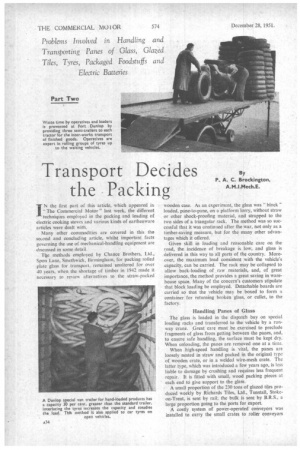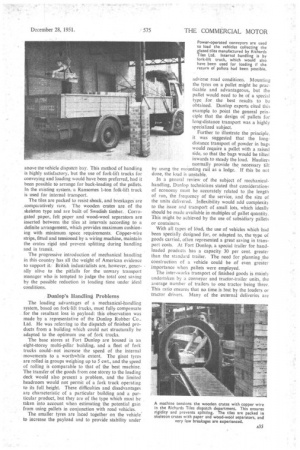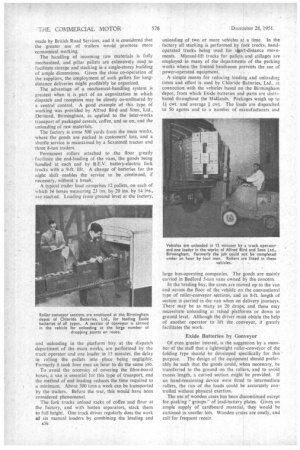Transport Decides the Packing
Page 44

Page 45

Page 46

If you've noticed an error in this article please click here to report it so we can fix it.
By P. A. C. Brockington, A.M.I.Mech.E.
IN the first part of this article, which appeared in " The Commercial Motor" last week, the different techniques employed in the packing and loading of electric cooking stoves and various kinds of earthenware articles were dealt with.
Many other commodities are covered in this the seLond and concluding article, whilst important facts governing the use of mechanical-handling equipment are discussed in some detail.
The methods employed by Chance Brothers, Ltd., Soon Lane, Smethwick, Birmingham, for packing rolled plate glass for transport, remained unaltered for over 40 years, when the shortage of timber in 1942 made it necessary to review alternatives to the straw-packed wooden case. As an experiment, the glass was " block " loaded, pane-to-pane, on a platform lorry, without straw or other shock-proofing material, and strapped to the Iwo sides of a triangular rack. The method was so successful that it was continued after the war, not only as a timber-saving measure, but for the many other advantages which it offered.
Given skill in loading and reasonable care on the road, the incidence of breakage is low, and glass is delivered in this way to all parts of the country. Moreover, the maximum load consistent with the vehicle's capacity, can be carried. The rack may be collapsed to allow back-loading of raw materials, and, of great importance, the method provides a great saving in warehouse space. Many of the concern's customers stipulate that block loading be employed. Detachable boards are carried so that the vehicle may be boxed to form a container for returning broken glass, or ctillet, to the factory.
Handling Panes of Glass
The glass is loaded in the dispatch bay on special loading racks and transferred to the vehicle by a runway crane. .Great care must be exercised to preclude fragments of glass from getting between the panes, and, to ensure safe handling, the surface must be kept dry. When unloading, the panes are removed one at a time.
When high-speed handling is vital, the panes are loosely nested in straw and packed in the original typz of wooden crate, or in a welded wire-mesh crate. The latter type, which was introduced a few years ago, is less liable to damage by crushing and requires less frequent repair. It is fitted with small, wood packing pieces at each end to give support to the glass.
A small proportion of the 230 tons of glazed tiles produced weekly by Richards Tiles, Ltd.,.Tunstall, Stokeon-Trent, is sent by rail; the bulk is sent by B.R.S., large proportion going to the ports for export.
A costly system of power-operated conveyors was installed to carry the small crates to roller conveyors anove the vehicle dispatch bay. This method of handling is highly satisfactory, but the use of fork-lift trucks for conveying and loading would have been preferred, had it been possible to arrange for back-loading of the pallets. In the existing system, a Ransomes 1-ton folk-lift truck is used for internal transport.
The tiles are packed to resist shock, and breakages are ,comparatively rare. The wooden crates are of the skeleton type and ai e built of Swedish timber. Corrugated paper, felt paper and wood-wool separators, are inserted between the tiles at intervals according to a . definite arrangement, which provides maximum cushioning with minimum space requirements. Copper-wire strips, fitted and tensioned by a wiring machine, maintain the crates rigid and prevent splitting during handling and in transit.
The progressive introduction of mechanical handling in this country has all the weight of American evidence to support it. British industrialists are, however, generally alive to the pitfalls for the unwary transport manager who is tempted to judge the total cost saving by the possible reduction in loading time under ideal conditions.
Dunlop's Handling Problems
The loading advantages of a mechanical-handling system, based on fork-lift trucks, must fully compensate for the resultant loss in payload: this observation was made by a representative of the Dunlop Rubber Co., Ltd. He was referring to the dispatch of finished products from a building which could not structurally be adapted to the optimum use of fork trucks.
The base stores at Fort Dunlop are housed in an eight-storey multi-pillar building, and a fleet of fork trucks could-not increase the speed of the internal movements to a worthwhile extent. The giant tyres are rolled in groups weighing up to 5 cwt., and the speed of rolling is comparable to that of the best machine. The transfer of the goods from one storey to the loading deck would also present a problem, and the limited headroom would not permit of a fork truck operating to its full height. These difficulties and disadvantages are characteristic of a particular building and a particular product, but they are of the type which must be taken into account when estimating the potential gain from using pallets in conjunction with road vehicles. The smaller tyres are laced together on the vehicle' to increase the payload and to provide stability under
adverse road conditions. Mounting the tyres on a pallet might be practicable and advantageous, but the pallet would need to be of a special type for the best results to be obtained. Dunlop experts cited this example to point the general principle that the design of pallets for long-distance transport was a highly specialized subject.
Further to illustrate the principle, it was suggested that the longdistance transport of powder in bags would require a pallet with a raised side, so that the bags would be tilted inwards to steady the load. Hauliers normally provide the necessary tilt by using the mounting rail as a ledge. If this be not done, the load is unstable.
In a general review of the subject of mechanicalhandling. Dunlop technicians stated that considerations of economy must be accurately related to the length of run, the frequency of the service, and the size of the units delivered. Inflexibility would add complexity to the issue and transport of small lots, which ideally should be made available in multiples of pallet quantity. This might be achieved by the use of subsidiary pallets or containers.
With all types of Idad, the use of vehicles which had been specially designed for, or adapted to, the 'type of goods carried, often represented a great saving in transport costs. At Fort Dunlop; a special trailer for handloaded products has a capacity 30 per cent, greater than the standard trailer. The need for planning the construction of a vehicle could be of even greater importance when pallets were employed.
The inter-works transport of finished goods is mainly undertaken by a conveyor and tractor-trailer units, the average number of trailers to one tractor being three. This ratio ensures that no time is lost by the loaders or tractor drivers. Many of the external deliveries are made by British Road Services, and it is considered that the greater use of trailers would promote more economical working.
The handling Of incoming raw materials is fully mechanized, and pillar pallets are extensively Used to facilitate storage and stacking in a single-storey building of ample dimensions. Given the close co-operation of the suppliers, the employment of such pallets for longdistance deliveries might profitably be organized.
The advantage of a mechanical-handling system is greatest when it is part of an organization in which dispatch and reception may be closely co-ordinated by a central control. A good example of this type of working was provided by Alfred Bird and Sons, Ltd., Deritend, Birmingham, as applied to the inter-works transport of packaged cereals, coffee, and so on, and the unloading of raw materials.
The factory is some 500 yards• from the main works, -where the goods are packed in customers' lots, and a shuttle service is maintained by a Scammell tractor and three 8-ton trailers.
Permanent rollers attached to the floor greatly facilitate the end-loading of the vans, the goods being handled at each end by &EN. battery-electric fork. trucks with a 9-ft. lift. A change of batteries for the night shift enables the service to be continued, if necessary, without a break.
A typical trailer load comprises 12 pallets, on each of which 14 boxes measuring 23 ins, by 20 ins. by 14 ins., are stacked. Loading from ground level at the factory, and unloading in the platform bay at the dispatch department of the main works, are performed by the truck operator and one loader in 15 minutes, the delay in rolling the pallets into place being negligible.
Formerly it took four men an hour to do the same job. To avoid the necessity of covering the fibre-board
boxes, a van is essential for this type of transport, and the method of end loading reduces the time required to a minimum. About 300 tons a week can be transported by the trailers. Before the war, this would have been considered phenomenal.
The fork trucks unload sacks of coffee and flour at the factory, and with batten separators, stack them
to full height. One truck driver regularly does the work of six manual loaders by combining the loading and A.36 unloading of two or more vehicles at a time. In the factory all stacking is performed by fork trucks, handoperated trucks being used for soort-distance movements. Manual-lift trucks for pallets and stillages are employed in many of the departments of the packing works where the limited-headroom prevents the use of
power-operated equipment. • A simple means for reducing loading and unloading times and effort is used by Chloride Batteries, Ltd., in connection with the vehicles based on the Birmingham depot, from which Exide batteries and parts are distributed throughout the Midlands. Packages weigh up to IA cwt. and average .1 cwt. The loads are dispatched to 50 agents and to a number of manufacturers and large bus-operating companies. The goods are mainly carried in Bedford 5-ton vans owned by the concern. In the loading bay, the cases are moved up to the van and across the floor of the vehicle on the conventional type of roller-conveyor sections, and an 8-ft. length of section is carried in the van when on delivery journeys. There may be as many as 20 drops, and these may necessitate unloading at raised platforms or down to ground level. Although the driver must obtain the help of another operator to lift the conveyor, it greatly facilitates the work.
Exide Batteries by Conveyor
Of even greater interest, is the suggestion by 'a mem ber of the staff that a lightweight roller-conveyor of the folding type should be developed specifically for this
purpose. The design of the equipment should preferably be such that the goods could, when necessary, be transferred to the ground on the rollers, and to avoid excess length, a curved section might be provided. If
an hand-tensioning device were fitted to intermediate rollers, the run of the loads could be accurately C011^ trolled without physical exertion.
The use of wooden cases has been discontinued except for packing "groups" of lead-battery plates. Given an ample supply of cardboard material, they would be cartoned in smaller lots. Wooden crates are costly, and call for frequent repair.












































































